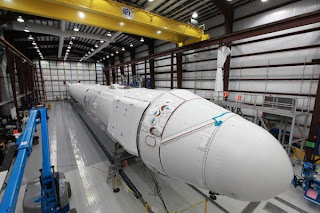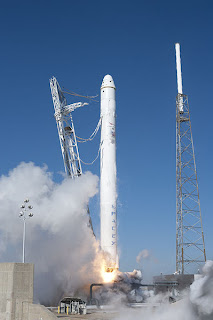The Falcon 9 rocket with Dragon cargo spacecraft.
Space Exploration Technologies, or SpaceX, builds the Falcon 9 rocket and the Dragon cargo spacecraft. They are the first among the private companies to build and launch an orbiting spacecraft. It could be said that Boeing, Lockheed, and other companies were first to build the Mercury, Gemini, Apollo and Shuttles but those who totally government operations. On December 9, 2010, SpaceX became the first privately funded company to launch, orbit, and recover their spacecraft.
SpaceX launch facility at Cape Canaveral.
Launched from LC-40 (from which NASA had launched all the Titan-3 and Titan-4 rockets from 1965 to 2005), the Falcon 9 rocket successfully placed the Dragon test spacecraft into an orbit 179 miles high. The Dragon made two successful orbits and then re-entered the atmosphere for a splashdown in the Pacific Ocean, being recovered within 20 minutes of touchdown.
COTS Demo Flight 1 blasts off.
The flight fulfilled many of the milestones required by the NASA Commercial Orbital Transportation Services contract (COTS). Additionally, after the Dragon spacecraft separated, the second stage was reignited and moved to a higher orbit of 6,800 miles, proving the system could reach higher orbits. SpaceX now prepares for further milestones in the contract with NASA.
Dragon perched on the Flacon 9, on pad LC-40 right now.
SpaceX plans to accomplish a major feat this weekend. In the early hours of Saturday morning, another Falcon-9 rocket will lift off with another Dragon capsule. This time, the capsule is full of supplies for the International Space Station. This mission is expected to fulfil the COTS demo fllights 2 and 3 together. The Dragon spacecraft will be guided to make a near pass of the ISS, and on a subsequent orbit, to approach the ISS within reach of the station's robotic arms. Astronauts of Expedition 30 will use the arms to grapple the Dragon and dock it to one of the hatches.
Computer graphic of Dragon about to be grappled by ISS.
We're all fingers crossed hoping the best for this mission. Should everything go well, SpaceX will be well on its way to providing regular cargo servicing of the ISS. There's an additional bonus for NASA to use the Dragon: It is the only cargo spacecraft capable of returning items from the ISS to the Earth. Both the ATV of Europe and the Progress of Russia routinely burn up in a re-entry.
Falcon-Heavy at the pad. Computer image.
SpaceX is not stopping with cargo delivery. They are well on their way to launching humans to space. Company founder Elon Musk has a vision to take his rockets all the way to Mars, eventually. To get moving on that path, the company's engineers are designing the Falcon-Heavy, which will be capable of lifting much larger payloads into orbit and beyond. More significantly, SpaceX is building a human-rated version of the Dragon capsule.
Inside DragonRider.
The crewed variant of the Dragon capsule will be called the DragonRider. As you can see in the picture above, it can hold up to 7 astronauts or a combination of personnel and cargo. SpaceX is currently building the first test capsules under the CCD program, which we talked about in an earlier blog. The company is also testing a launch abort system, and expects to fly the DragonRider by 2016.
All photos for this blog post are credited to SpaceX.
All photos for this blog post are credited to SpaceX.








No comments:
Post a Comment